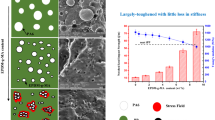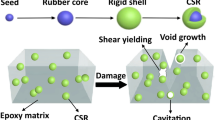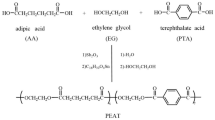Abstract
In this article, a series of commercial bimodal polyethylene-100 (PE100) resins were synthesized to clarify the effect of molecular weight distribution (MWD) on rheological, crystallization and mechanical properties of bimodal PE. The GPC results show that the three GC100S samples with similar MWD merely differ in the ratio of low molecular weight (MW) fraction which gradually ascends from 50 % to 58 %. Rheological measurements were performed to show that the low MW fraction which has the function of dilution and lubrication can obviously decline the melt elasticity and increase the onset shear rate of shark-skin failure, which dramatically improve the processability of GC100S. Furthermore, isothermal crystallization and stepwise segregation crystallization were studied by differential scanning calorimetry (DSC). It appears that the introduction of homopolymerized low molecular fraction could remarkably promote the crystallization capacity and form thick lamellae, which eventually improve the rapid crack propagation (RCP) resistance of PE100 pipe. On the other hand, uniaxial tensile test was used to evaluate slow crack growth (SCG) resistance of PE100 pipes. It shows that the concentration of intercrystalline tie molecules declines with the increasing ratio of low MW fraction, which slightly deteriorates the SCG resistance.






Similar content being viewed by others
References
Sun X, Yang MB (2011) Fracture behavior of bimodal polyethylene: effect of molecular weight distribution characteristics. Polymer 52(2):564–570
Krumme A, Viikna A (2004) crystallization behavior of high density polyethylene blends with bimodal molar mass distribution 1. Basic characteristics and isothermal crystallization. Eur Polymer J 40(2):359–369
Song SJ, Yang YL (2008) Effect of small amount of ultra high molecular weight component on the crystallization behaviors of bimodal high density polyethylene. Polymer 49(12):2964–2973
Hubert L, Seguela R (2001) Physical and mechanical properties of polyethylene for pipes in relation to molecular architecture. I. Microstructure and crystallization kinetics. Polymer 42(20):8425–8434
Hubert L, Seguela R (2002) Physical and mechanical properties of polyethylene for pipes in relation to molecular architecture. II. Short- term creep of isotropic and drawn materials. J Appl Polym Sci 84(12):2308–2317
Covezzi M (1995) The spherilene process: linear polyethylenes. Macromol Symp 89(1):577–586
Frank P (2001) Bimodal polyethylene-Interplay of catalyst and process. Macromol Symp 163(1):135–144
Lu XC, Brown N (1996) The critical molecular weight for resisting slow crack growth in a polyethylene. J Polymer Sci, Part B: Polymer Phys 34(10):1809–1813
Yamaguchi M, Gogos CG (2002) Relation between molecular structure and flow instability for ethylene/α-olefin copolymers. Polymer 43(19):5249–5255
Aguilar M, Vega JF (2001) New aspects on the rheological behaviour of metallocene catalysed polyethylenes. Polymer 42(24):9713–9721
Vega JF, Santamaria A (1998) Small-amplitude oscillatory shear flow measurements as a tool to detect very low amounts of long chain branching in polyethylenes. Macromolecules 31(11):3639–3647
Gahleitner M (2001) Melt rheology of polyolefins. Prog Polym Sci 26(6):895–944
Mavridis H, Shroff RN (1992) Temperature dependence of polyolefin melt rheology. Polym Eng Sci 32(23):1778–1791
Vega JF, Munoz-Escalona A (1996) Comparison of the rheological properties of metallocene-catalyzed and conventional high-density polyethylenes. Macromolecules 29(3):960–965
Khanna YP (1990) A barometer of crystallization rates of polymeric materials. Polym Eng Sci 30(24):1615–1619
Avrami M (1939) Kinetics of phase change I. J Chem Phys 7(12):11032–11121
Avrami M (1940) Kinetics of phase change II. J Chem Phys 8(2):2122–2241
Anantawaraskul S (2005) Fractionation of semicrystalline polymers by crystallization analysis fractionation and temperature rising elution fractionation. Adv Polym Sci 182:1–54
Tarasova E, Viikna A (2011) Triple crystallization behavior of fractionated ethylene/α-olefin copolymers of different catalyst type. J Polym Res 18(2):207–216
Cazenave J, Seguela R (2006) Short-term mechanical and structural approaches for the evaluation of polyethylene stress crack resistance. Polymer 47(11):3904–3914
Lu X, Brown N (1995) The effect of crystallinity on fracture and yielding of polyethylene. Polymer 36(22):4239–4244
Witold B, Willi F (1986) Impact energy and rapid crack propagation in plastic pipes. Polymer 27(1):76–79
Plummer CJG (2004) Microdeformation and fracture in bulk polyolefins. Adv Polym Sci 169:75–119
Lustiger A, Markham RL (1983) Importance of tie molecules in preventing polyethylene fracture under long-term loading conditions. Polymer 24(12):1647–1654
Chen Y, Liu PB (2013) Investigations of environmental stress cracking resistance of HDPE/UHMWPE and LDPE/UHMWPE blends. J Polym Res 20:141
Bhattacharya SK, Brown N (1985) The initiation of crack growth in linear polyethylene. J Mater Sci 20(8):2767–2775
Brown N, Lu X (1995) A fundamental theory for slow crack growth in polyethylene. Polymer 36(3):543–548
Haager M, Pinter G (2004) Estimation of slow crack growth behavior in polyethylene after stepwise isothermal crystallization. Macromol Symp 217(1):383–390
Peres FM, Schon CG (2007) An alternative approach to the evaluation of the slow crack growth resistance of polyethylene resins used for water pipe extrusion. J Polym Res 14(3):181–189
Frank A, Freimann W (2009) A fracture mechanics concept for the accelerated characterization of creep crack growth in PE-HD pipe grades. Eng Fract Mech 76(18):2780–2787
Sharif A, Mohammadi N (2008) Practical work of crack growth and environmental stress cracking resistance of semicrystalline polymers. J Appl Polym Sci 110(5):2756–2762
Crist B, Metaxas C (2004) Neck propagation in polyethylene. J Polym Sci B Polym Phys 42(11):2081–2091
Humbert S, Vigier G (2009) Polyethylene yielding behaviour: what is behind the correlation between yield stress and crystallinity. Polymer 50(15):3755–3761
Seguela R (2007) On the natural draw ratio of semi-crystalline polymers: review of the mechanical, physical and molecular aspects. Macromol Mater Eng 292(3):235–244
Cheng JJ, Polak MA (2008) A tensile strain hardening test indicator of environmental stress cracking resistance. J Macromol Sci A Pure Appl Chem 45(8):599–611
Kurelec L, Teeuwen M (2005) Strain hardening modulus as a measure of environmental stress crack resistance of high density polyethylene. Polymer 46(17):6369–6379
Yang Y, Wang XJ (2013) Effect of the contribution of crystalline and amorphous phase on tensile behavior of poly (phenylene sulfide). J Polym Res 20:198
Kuriyagawa M, Nitta K (2011) Structural explanation on natural draw ratio of metallocene-catalyzed high density polyethylene. Polymer 52(15):3469–3477
Author information
Authors and Affiliations
Corresponding authors
Rights and permissions
About this article
Cite this article
Wu, T., Yu, L., Cao, Y. et al. Effect of molecular weight distribution on rheological, crystallization and mechanical properties of polyethylene-100 pipe resins. J Polym Res 20, 271 (2013). https://doi.org/10.1007/s10965-013-0271-9
Received:
Accepted:
Published:
DOI: https://doi.org/10.1007/s10965-013-0271-9




